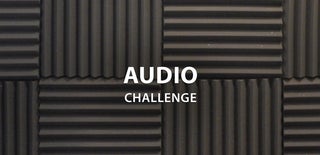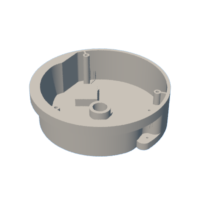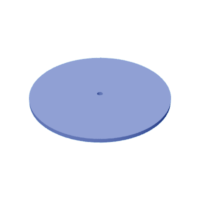Introduction: Building a Portable Bluetooth Spinning Record Player
- Work in progress -
Hello fellow makers,
In this Instructable I would like to show you a prototype for a portable record player that I'm busy designing. The idea is to have a small easily transportable record player where the record remains stationary and the player spins, the music is then transmitted to a Bluetooth speaker or headphones via the built in Bluetooth transmitter.
For now it is in it's most basic form as I just wanted to test the concept but moving forward I want to keep this an open source project that people can make and alter to their needs.
It is for now very much still a work in progress as I try and perfect it, but I would love if the Instructable community joins me on this journey.
In its current state the drive system along with the Bluetooth transmitting is working flawlessly I just need to perfect the tonearm design without sacrificing portability.
Join me on the journey I've taken so far...
Step 1: What You Will Need:
To make your own you will need the following:
- Access to a 3D printer
- 5V DC motor with worm gearbox
- Ceramic record player cartridge
- USB Bluetooth audio transmitter
- Arduino Nano or smaller
- H-Bridge motor driver
- *Arduino and motor driver can be replaced by a PWM motor speed controller.
- 14500 Lithium ion battery or a small LIPO battery
- 3.7v to 5v step up module
- TTP223 Touch module
- 1A NPN Transistor
- 1K Resistor
- 4mm OD 2mm ID Teflon tube (3D printer filament guide tube)
- 3.5mm to 3.5mm AUX cable (There should be one included with the transmitter)
- 2X 624 bearings
- 2X 682 bearings (teflon tube can also be used here)
Step 2: Design and Print:
I am using Fusion 360 to design the player and included the .f3d files that I will keep updated as I make progress on the project.
At the moment the fusion design files are a bit of a mess as there are a lot of revisions but by going through the timeline you should be able to make out all of the parts if you want to change something.
I recommend printing with PETG as it will still give you the stiffness of PLA with added thermal resistance and is also slightly lighter.
My print settings are as follows:
Material: Sunlu PETG
Speed: 40mm/s
Temp: 250 deg C
Bed: 80 deg C
Nozzle: 0.4mm
The cartridge holder and main body will need supports enabled.
Files:
I have included the Tinkercad, .3mf and also the fusion 360 files so that you can edit it to suit your needs.
Step 3: The Main Body:
So far this is the only version of the main body that I've designed and printed as it serves as a good working starting point.
As some of my overhangs did not print well I used some poly filler over the print and sanded it down before painting it satin black.
In the centre of the main body we need to press in the two 624 bearings on top of each other, depending on the tolerances of your printer you might need to add some glue like CA glue (super glue) to keep the bearings securely in place.
Make sure your bearings are perfectly flat with the body or it will cause a wobble when spinning.
Step 4: The Tonearm:
Update: as seen in pictures I have now started testing a new tonearm design.
This is the part I'm having the most problems with.
This original design worked in my testing phase but with everything assembled it played only a certain section of the record and skidded on the outermost and innermost sections.
I'm currently working on a way to extend the arms length without adding a lot of inertia whilst spinning. I now have two arms, the first one extends out and locks into place and then the second arm moves freely on the end of the first.
I also want another way to adjust the tracking weight.
Now for the cartridge holder.
After printing I used a 4mm drill bit to enlarge the hole on which the holder will pivot on (it is printed with a 2mm hole otherwise it will be impossible to print except if you use a SLA printer).
Now cut off a 6-7mm piece of teflon tubing and press it into the hole, this should give you a nice slippery bushing.
An easy way for me during testing to adjust the tracking force was to use a piece of 4mm bronze rod with various sizes of ball bearing brazed on top of it that can then be pushed into the top of the holder and also acts as a knob to pick up the stylus from the record.
Step 5: The Drive:
When it comes to record players we usually see three common types of drive systems.
There's the most common belt drive that uses a motor with a small pulley to drive the platter using a belt around the platter, this gives you the needed speed reduction needed.
Unfortunately this is not an option that could be implemented in this design.
Next we have a rubber wheel attached to the motor that presses inside of the platter to drive it. This can be used in my design but I think there are more things that could go wrong and it would complicate the design.
And finally there's the direct drive system, this is where the motor is directly coupled to the platter. Unfortunately this system uses a specialised low rpm motor and drive system.
The easiest way I could think of was to use a worm gearbox to drive the record player, this gave me a low rpm high torque drive to use in testing.
In the future I would like to test low rpm brushless motors like the ones used in gimbals with a pure sine wave controller.
The motor speed is controlled via a potentiometer connected to an Arduino and H-bridge motor driver.
The code used to control the Arduino was taken from thisInstructable
Step 6: The Electronics:
**Schematic to be added**
The Arduino + motor driver could be replaced with a simple PWM motor speed controller module but I decided to go with a microcontroller so that we can add new features like PID speed control and auto start/stop to the device in the future with some additional sensors and coding.
For this project to function at all we needed a way to transmit audio without any wires.
Now we could have added a small amplifier and speaker but that would have added a lot of complexity and would have resulted in a small sound stage.
Instead I decided to go with a Bluetooth audio transmitter that can easily be bought on Amazon that then connects to any available Bluetooth device to give you a much better listening experience.
To power everything I use a Lithium Ion battery (14500 size in the pictures but I would suggest a CR123/16340 or LIPO pouch) that is connected to a 3.7v to 5v step up module to supply all the electronics with a clean 5 volts.
Next problem was how to stop the record player when it's spinning..
The solution I came up with was to fit a TTP223 touch sensor to the lid that controls a PNP transistor when you hover your hand over the lid, this allows you to turn off the power going to the drive system without having to psychically touch the device.
Step 7: Assembling: Part 1
Assembly of the device is quite straight forward.
First we need to take a 4mm shaft 40mm in length and press it into the bottom disk, whilst doing this you need to make sure that it goes in perfectly straight or else the device will wobble.
TIP: I use my press drill to press in shafts and bearings.
Now press the shaft through the bearings in the bottom of the main housing, keep about 2-3mm between the housing and the bottom plate. Add a drop of CA glue to secure it to the bearings, just be careful to not get any glue into the bearings or they will cease up.
Next push the gear of the worm gearbox onto the shaft and glue into place (place your motor on the block in the housing and just make sure you glue the gear in at the correct height)
Step 8: Assembling: Part 2
Now we are going to assemble the tonearm...
THIS WILL BE UPDATED AS I MAKE PROGRESS ON THE IMPROVED TONEARM
First I took a 3.5mm AUX cable, cut off the one end and stripped the insulation to give me thin flexible wires for the tonearm with a 3.5mm plug that plugs into the Bluetooth transmitter without any further modifications.
In the initial design I didn't model any holes for the wires as I was still unsure where I would be running then through so I had to manually drill the holes.
I then press the two 682 bearings into the hole in the arm as pictured, this gives a nice low friction pivot point for the arm.
Position the tonearm into its indent in the main body and press the ~30mm 2mm shaft through to hold it in place.
Feed the wires from the AUX cable through the holes in the main body and tonearm and then solder on the lugs of the cartridge.
Step 9: Assembling: Part 3
The final part of assembly...
First I glued the tonearm wires into the arm using some hot melt glue, this allows me to remove the glue if needed using some isopropyl alcohol and it also dampens some vibrations that can be transmitted to the stylus.
Next align the holder holes with the holes in the tonearm and sucure it by pushing through a 2mm rod.
As you can see the electronics are still a mess, I just stuck everything in place with some double sided tape for the time being whilst testing.
As you can see in the picture I added a small push switch to turn on the main power as well as the touch module that controls power to the drive unit.
With everything in place you can go ahead and screw the lid in place with three 3mm self tapping screws.
Step 10: First Test:
Here we go....
I would suggest you start without the cartrige just to make sure all the main components work.
Next you will use the potentiometer to adjust your speed
My first attempt was a success until here, the drive and Bluetooth transmission works perfectly but unfortunately like I mentioned earlier the player does not want to play the edges of the record and skids.
Tip: Always use a cheap unwanted bargain bin record to test on!
Now on to the revised tone arm.
Step 11: The Next Step..
I will continue to update this Instructable as I make improvements and would appreciate any tips and advice on how to improve the design.
To do list:
- Add a charging circuit
- Automatic stop at end of record
- Adjustable tracking weight
- PID speed control
I hope you guys enjoyed this Instructable and if you have any questions please feel free to leave me a comment below.
Please share your own creations with us by clicking the "I Made It" button below.
Happy making!

Second Prize in the
Audio Challenge




















